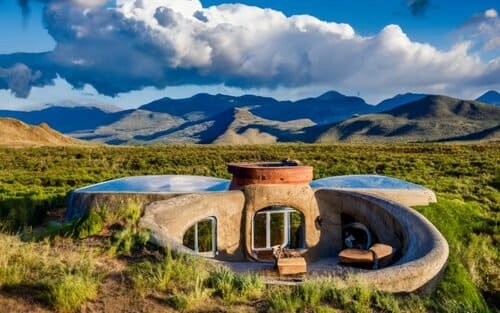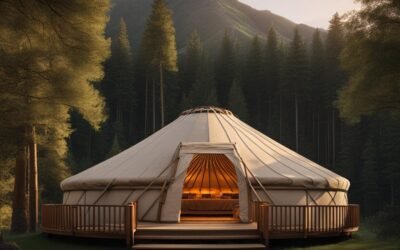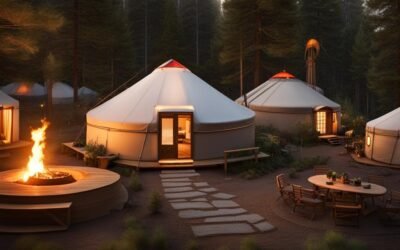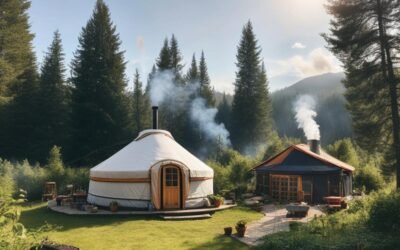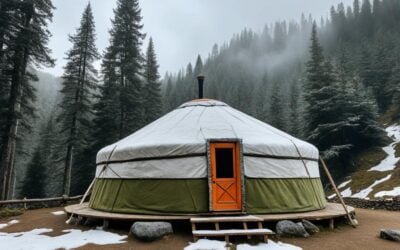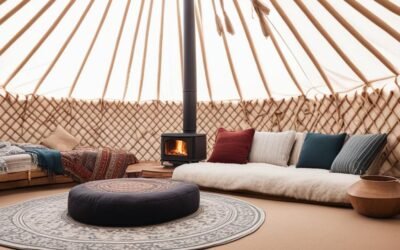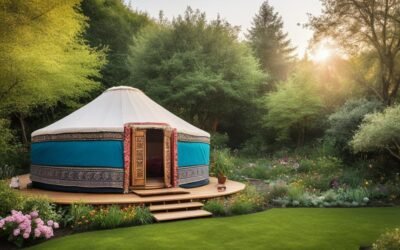Yurts offer an affordable and alternative way of living, but understanding the costs involved is essential. In this article, I will explore the various factors that contribute to yurt costs and provide you with a comprehensive guide to help you create a cozy home on a budget.
Key Takeaways:
- Yurts provide an affordable and unique living option.
- Understanding the costs involved in yurt living is crucial.
- Factors such as size, customization, and additional options impact yurt costs.
- Yurts offer lower construction costs and reduced maintenance compared to traditional homes.
- While there are challenges and additional costs, living in a yurt offers a closer connection to nature and a simpler lifestyle.
Continuing on, let’s dive into the pros and cons of living in a yurt to further understand its appeal and potential drawbacks.
Pros of Living in a Yurt
Yurts offer numerous advantages that make them an attractive option for affordable living. Let’s explore the pros of choosing yurt living:
- Lower Construction Costs: Yurts are known for their budget-friendly housing options. Compared to traditional homes, yurts require fewer materials and skip complex construction steps, resulting in significant cost savings. This makes yurts a more affordable housing choice for those on a tight budget.
- Lower Maintenance Costs: Yurts have simple exterior structures and don’t have eaves or gutters, which contribute to lower maintenance requirements. This means less time and money spent on repairs and upkeep, allowing you to enjoy a hassle-free lifestyle.
- Portable Housing: One of the unique features of yurts is their portability. If you ever need to relocate, you can easily dismantle and transport your yurt to a new location. This flexibility offers the freedom to live in different areas without the expense and hassle of selling a traditional home.
- Yurt Resale Value: Yurts hold their resale value well, making them a wise investment. If you decide to move on from yurt living in the future, you can sell your yurt and potentially recoup a significant portion of your initial investment.
- Reduced Taxes: Depending on your location, owning a yurt may come with certain tax benefits. Some areas classify yurts as temporary or portable structures, making them exempt from certain property taxes. This can further contribute to the affordability of living in a yurt.
- Strength and Flexibility: Yurts are built to withstand various weather conditions, thanks to their strong and flexible structures. Whether it’s high winds, heavy snow, or extreme temperatures, yurts provide a safe and secure living space.
- Quicker Building Process: Constructing a yurt is typically quicker compared to traditional homes. With fewer complex steps involved, the building process can be completed in a shorter timeframe, allowing you to start enjoying your cozy yurt home sooner.
- Connection to Nature: Living in a yurt provides a unique connection to nature. The circular shape, natural materials, and large windows of yurts allow for ample natural light and panoramic views of the surrounding environment. Embracing the outdoors and feeling connected to the natural world can enhance the overall living experience.
Quote:
“Yurts offer not only affordable living but also a simpler and more flexible lifestyle. With lower construction and maintenance costs, portability, and a connection to nature, yurts provide a unique housing solution for those seeking budget-friendly and sustainable living.” – Jane Smith, Yurt Enthusiast
Living in a yurt offers a range of benefits that go beyond affordability. From the reduced construction and maintenance costs to the strength and flexibility of the structures, yurts provide a comfortable and eco-friendly housing option. The unique experience of living in a yurt allows for a closer connection to nature, creating a harmonious blend of shelter and outdoor living.

Cons of Living in a Yurt
While yurts offer numerous benefits, it is important to consider some of the challenges and drawbacks that come with living in a yurt.
1. Financing Challenges
Obtaining financing for a yurt can be challenging due to their non-traditional nature. Banks often view yurts as unconventional and may be hesitant to provide loans for their construction or purchase.
2. Permit Difficulties
Obtaining permits for yurts can also be problematic, especially in areas with stricter building codes. Some municipalities may have specific regulations or restrictions that make it difficult to legally set up a yurt as a primary residence or even a secondary structure on your property.
3. Temperature Control Issues
One of the challenges with yurt living is temperature control. Compared to traditional homes, yurts have thinner insulation and may require extra heating during colder months. Cooling the yurt during hot summers can also be a challenge, especially without proper ventilation systems.
4. Additional Expenses for Customization and Utilities
While yurts offer flexibility for customization, adding special features or making alterations to the yurt’s design can result in additional expenses. This includes installing windows, doors, skylights, or insulation to improve comfort and energy efficiency. Furthermore, connecting utilities such as electricity, plumbing, or internet services may require extra effort and cost.
Despite these challenges, many yurt dwellers find creative solutions and embrace the unique aspects of yurt living. It’s essential to weigh these cons against the benefits and consider whether the yurt lifestyle aligns with your preferences and circumstances.
Understanding Yurt Costs: Pricing and Options
When considering yurt costs, it’s essential to understand the pricing and options available. The price of a yurt can vary significantly based on size and customization choices. Smaller yurts, such as 12′ diameter yurts, tend to be more affordable, while larger ones, like 40′ diameter yurts, can be more expensive.
Size is an important factor to consider when determining the cost of a yurt. The specific needs and purpose of the yurt, as well as the number of occupants, should be taken into account.

Customization options also impact the overall cost of a yurt. Additional features such as windows, doors, skylights, and insulation can enhance the comfort and functionality of the yurt but may come with an additional price tag.
| Additional Options | Price Range |
|---|---|
| Windows | $200 – $500 per window |
| Doors | $400 – $1000 depending on material and design |
| Skylights | $300 – $800 per skylight |
| Insulation | $800 – $2000 depending on the size of the yurt |
When planning the budget for a yurt, it is essential to consider the costs of platform construction, furniture, and utilities. The platform serves as the foundation for the yurt, and its construction costs may vary depending on factors such as site preparation and materials used.
Overall, understanding the pricing and options available for yurts will help you make informed decisions when creating your ideal living space. Consider your specific needs, desired customization, and the associated costs to find a yurt that fits both your budget and lifestyle.
Conclusion
Yurts offer an affordable and unique way of living, making them an excellent choice for those seeking budget-friendly housing options. With lower construction costs and reduced maintenance requirements, yurts provide an opportunity to create a cozy home while saving money. One of the notable advantages of yurt living is the strong connection to nature, allowing individuals to embrace a simpler lifestyle.
While there are challenges and additional costs to consider, such as financing difficulties and temperature control issues, the benefits of yurt living outweigh the drawbacks for many. Yurts offer portability, quick construction processes, and lower maintenance costs, making them suitable for a variety of purposes, including full-time living, auxiliary buildings, or rental properties.
By understanding the various factors that contribute to yurt costs, individuals can make informed decisions and tailor their yurt to meet their specific needs. From choosing the appropriate size and considering customization options to factoring in expenses like furniture and utilities, careful planning ensures a budget-friendly yurt construction project.
Overall, yurts provide an affordable and sustainable alternative to traditional housing options. With their unique charm, reduced environmental impact, and cost-effectiveness, yurts offer an attractive choice for those looking to embrace a simpler lifestyle and connect with nature.
FAQ
What are the pros of living in a yurt?
Yurts offer several advantages, including lower construction costs, reduced maintenance, portability, high resale value, reduced property taxes, strength and flexibility, quick building process, and a unique connection to nature.
What are the cons of living in a yurt?
Some cons of living in a yurt include challenges in obtaining financing and permits, difficulty in temperature control, and potential additional expenses for customization and utilities.
How much does a yurt cost?
Yurt costs vary depending on factors such as size and customization options. Prices range from ,000 to ,000, with smaller yurts being more affordable and larger ones more expensive.
What factors affect the cost of a yurt?
The size of the yurt, customization options such as windows, doors, skylights, and insulation, as well as expenses for platform construction, furniture, and utilities, all contribute to the overall cost of a yurt.
Are yurts an affordable housing option?
Yes, yurts offer an affordable alternative for those seeking budget-friendly housing options. They have lower construction costs and reduced maintenance requirements compared to traditional homes.




